|
JAMES FERGUSSON
|
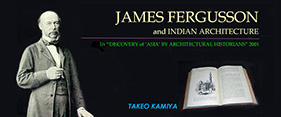
|
JAMES FERGUSSON
|

Despite being the author of some great works on the history of architecture, few people in Japan know the name of the British architectural historian James Fergusson (1808-86). Fergusson was writing on the history of world architecture no less than thirty years earlier than Banister Fletcher's famous "A History of Architecture" (*1) and he was compared to the ancient Roman auther architect Vitruvius in recognition of his deep thinking and prolific and popular work. (*2) Heinrich Schliemann, an archaeologist who had excavated Troia, dedicated one of his principal books, the "Tiryns", to Fergusson. The RIBA (Royal Institute of British architects) awarded him a royal gold medal owing to his brilliant achievements concerning his research on the history of architecture. In Japan, for the first educational teachings of architectural history in the Meiji era, at the architectural courses in the Great Institute of Technology, and in the Imperial University of Tokyo, it was his books that were used as textbooks. In the pre-World War II period, Hideto Kishida, the then professor of the Imperial University of Tokyo, heard from Chuta Ito, the first Japanese architectural historian, that 'the lectures of the history of architecture were by and large direct translations and instructions from Fergusson's book the "History of Architecture", 1874 ...' (*3) Most of the Japanese architects who grew up in the Meiji era must have been familiar with his name. However, probably on account that none of his books were translated into Japanese, his name has almost sunk into oblivion, while Fletcher's "A History of Architecture on the Comparative Method" (*4) became widespread. In spite of Fergusson's great contribution to the history of architecture, scholars have hardly studied the development of his writings. It would be partly due to the difficulty of grasping the entire substance of his work because of the extremely wide range of his writings, and partly because his greatest achievement consisted of systematizing the history of Indian architecture, whereas the focus of study in Japan was on the West.

In Japan Chuta Ito in the Meiji era and Shun-ichi Amanuma in the Taisho era had been interested in Indian architecture and had actually traveled in India, but no later architectural historians followed them, leaving Indian architecture neglected. There were no scholars who specialized in Indian architecture; therefore the society of architectural history in Japan could not properly locate Fergusson in extent of the history of Indian and World architecture. Not surprisingly his name is not found in the Japanese "Grand Dictionary of Architecture and Construction". More recently, as the study of Asia has begun to thrive, at length greater attention has been paid to Fergusson. (*5) The aim of this article is to make a general survey of Fergusson's pursuit of the history of Indian architecture. However, given that his full-length picture is not known I put aside examination of every detail in his works for the present, I am going to observe how he made his history of Indian architecture, in correlating with all his whole writings about world architecture.
James Fergusson became one of the leading architectural historians in the 19th century and was awarded many honors. Fergusson had, according to William White's article, close to ten titles such as C.I.E., D.C.L. Oxon., LL.D. Edin., F.R.S., F.G.S., Vice-President of the Royal Asiatic Society, a Past Vice President of the Royal Institute of British Architects, etc. However, Fergusson did not study architecture in a university. He taught himself after graduating from a private school and pursued world architecture at his own expense, going on to publish many treatises and books. He was not an academic architectural historian, not surprising when you know that one apprenticed oneself in an architect's atelier rather than in a university to become an architect at that time. Furthermore, that gave him a free spirit. He would look at historical monuments with his own eyes and think independently without adherence to the established theories in the academic community or conventions in architectural society, and persisted in his own views however opposed they might have been to the current of the times.
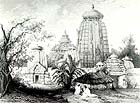
As a critical biography of James Fergusson has not been published even in his native country, details of the process of his study are not known, nor is his private life. According to fragmentary descriptions in many books, we have been able to reconstruct an outline of his life as follows: (*6) James Fergusson was born in 1808 at Ayr, the capital of the old Ayrshire State in Scotland, as the second son of a medical officer, Dr. William Fergusson. Owing to his father's job relocations he attended the High School in Edinburgh, then went to a private school in Hounslow. After graduation at the age of around twenty he emigrated to India. He was destined for employment in the firm of Fairlie, Fergusson, and Co., in Calcutta, where his older brother was a partner. But the company soon failed and he became an indigo planter and also started a new business in Calcutta along with his brother William. His indigo plantation was successful and brought him riches. However, he preferred to become a scholar of architecture rather than to continue the business. It seems, as a result of his life in India,that he judged himself more suitable for a life of studies than commercial pursuits, traveling to ancient sites and developing his childhood interest in antiquities and foreign buildings. Putting an end to his ten years commercial activity in Calcutta, he returned to London. He purchased a home in Langham Place and frequented libraries, immersing himself in the study of architecture. For about ten years between 1834 and 1843 he went to India repeatedly, investigating Indian architecture and taking numerous field notes. It seems that he also traveled in Europe and the Middle East on the way to India. It is not clear when and which parts of India he traveled to due to discrepancies among various descriptions.
Although his last travel to India was in 1845, he wrote his first treatise the previous year and read it at the Royal Asiatic Society of Great Britain and Ireland at the end of the year. This was "On the Rock-Cut Temples of India", and Fergusson was thirty-five years old.
After that time Fergusson unremittingly collected architectural documents all over the world adding to his previous ten year accumulation, developed them theoretically, and read his papers. He published many books, revising and enlarging them tirelessly to perfection until his demise at the age of seventy-seven.
To begin with, I placed all Fergusson's writings into four categories. The first category is the History of Indian architecture, which he pursued through the better part of his life. The second is the sphere of History of World architecture from ancient times to the Middle Ages. And the third is that of modern times, the Renaissance to the 19th century. I placed his other works in the fourth column, Miscellaneous. Articles in journals are also in this group, even though their themes correspond to the former three categories.
The best representative works of the first three lineages are "A History of Architecture in All Countries", the "History of Indian and Eastern Architecture", and the "History of Modern Styles of Architecture". One may refer to these widespread books as his 'trilogy'. His first publication was the "Illustrations of the Rock-Cut Temples of India" in 1845, the text of which was the aforementioned paper "On the Rock-Cut Temples of India." He added many measured drawings to make it a small book, with which he combined the eighteen pieces of large-sized lithographs made by T.C. Dibdin based on Fergusson's original drawings. He wrote in the preface of this book that at the beginning he had not intended to publish a book just about the cave temples apart from other sort of architecture. His original plan was to publish a book with around 100 pieces of lithographs of the ancient Buddhist, Hindu, and Islamic buildings. So he hoped to introduce the totality of Indian architecture and its masterpieces, but considering the excessive cost he completed the cave temples as a first step. He was not necessarily interested in cave temples more than stone constructed buildings.
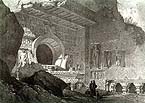
His next luxurious publication accordingly was 24 large-sized lithographs of stone-built architecture in India together with a 70 page explanation published in 1848 as the "Picturesque Illustrations of Ancient Architecture in Hindostan", which got such a good reputation it was reprinted. The book that had the great influence on Fergusson's accomplishment of his work was "An Attempt to Discriminate the Styles of English Architecture" written by Thomas Rickman (1776 -1841) in 1817. (*8) Rickman, who was an architect as well as a researcher of English church buildings, had classified Gothic architecture in England into smaller groups and had established the appellations, such as 'Norman', 'Early English', 'Decorated', and 'Perpendicular', of which he explained the characteristics clearly in the book. So the book 'scientifically' clarified that it is above all 'style' that classifies each piece of architecture and settles its age, and determined it as the principle notion in the 19th century for the study of the history of architecture.
Fergusson was deeply impressed with the book and thought that the notion of 'style' would be effective not only in Britain but even more so in India. (*9)

Fergusson's first full-dress theoretical book is "An Historical Inquiry into the True Principles of Beauty in Art, more Especially with Reference to Architecture" published in 1849 (hereinafter referred to as "Historical Inquiry" in this essay). (*10)
In the beginning of the 19th century, before which Neo-Classicism had been dominant in the society of British architecture, new architects and theoreticians appeared who objected to it. Pugin, one of the representatives of that movement, insisted that the true figure of Christian architecture resided in the Gothic style and that the Classic style of pagan Greece and Rome was unsuitable.
The revivalists such as Pugin and George Gilbert Scott (who would go on to design the Library and Convocation Hall of Bombay University in India afterward) spread the trend of 'praise to the Middle ages' among British architects, in designing new churches in the Gothic style.
Fergusson thought as highly of the Gothic architecture as Pugin, but he judged it inappropriate to apply a past style to a new building in the present day (Fergusson's 19th century) since the social system and people's mentality were completely different from those in the Middle Ages. He acknowledged many other styles all over the world as well as Gothic and concluded that they were beautiful and worthy because they were the best-adapted styles for the demands and needs of the age and society that they belonged to. He referred to that legitimacy as the 'True Principles'.
Having started from Indian architecture, he researched architecture throughout the world and studied the style-classification and those characteristics. He developed this view of architecture and decided to publish it as a theoretical writing in the aforementioned "Historical Inquiry".
It was John Murray, a proprietor of a long-established publishing company issueing a wide range of books, from general books to scholarly, who paid attention to this book. John, who was coincidentally the same age as Fergusson, recommended that he rewrite his study in geographical order.
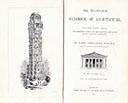
Since its exact title is so long; "The Illustrated Handbook of Architecture: Being a Concise and Popular Account of the Different Styles of Architecture Prevailing in All Ages and Countries", I shall simply refer to it as "the Handbook" in this article. Fergusson, who was compared to Linné in the field of botany, (*14) classifying passionately the architecture of the world, intended to insert figures in this book as profusely as possible. As the technique of photoengraving did not yet exist, he had as many as 840 minute architectural drawings engraved on the end grain of woodblocks, a method developed by Thomas Bewick and popular at the time. So it became an unprecedented publication that showed pictorially diverse architectural styles from all over the world. Combined with the clear descriptions, the book gained a favorable assessment and was reprinted.
The book was also diffused on the European continent and even in America. As for Japan, "The Rules and Subjects of study of the Great Institute of Technology" (1885) mentioned Fergusson's "The Illustrated Handbook of Architecture" as one of its reference books. (*15) Which means that many Japanese students of architecture might have bought copies of this book too. The "Handbook" dealt with world architecture, the order being India, China, Western Asia, Egypt, Greece, Rome, Persia, and Islam in the first volume. The second volume dealt with European medieval architecture in the order of France, Belgium, Germany, Italy, Portugal, Britain, Northern Europe, and then added Byzantine lastly. Seeing that the half of the book was dedicated to Europe, one might consider that Fergusson was Eurocentric. However, as shown in the aforementioned quotation, he intended to deal with worldwide architectural styles as thoroughly as possible. Such an attitude was rare in the 19th century and it can be said that he was a 'cultural relativist', to use a current term. (*16) Even so, it is possible to surmise from his writings that he considered the architecture of ancient Greece and medieval Europe particularly valuable. Regarding India and neighboring countries, he spent 171 pages on them in his book. Here, for the first time, even if it was not sufficiently matured,Indian architecture was described in its totality . (Table 2)
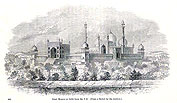
The "Handbook" is a voluminous work in which each page has the largest quantity of words among Fergusson's books and its total number of pages exceeds 1,000. One could feel awkward that it is entitled 'handbook' like a light book.
Fergusson writes in the preface of this book that studies of architecture were 'the mere amusement of the amateur' in the 18th century, but 'new principles of criticism have been evolved' in the 19th century and studies of architecture 'are now becoming objects of philosophical inquiry, and assuming a rank among the most important elements of historical research ( . . . ) and have made such rapid and satisfactory progress' during the first fifty years of the 19th century.
He wrote that the tendency of 'imitation of forms and orders' employed in ancient Greece and Rome that was prevalent fifty years ago (i.e. fifty years before Fergusson's time), but at the present day (i.e. middle of the 19th century) it has switched over to the 'correct reproductions of mediaeval designs (i.e. the Gothic style)'. However, these are 'the mere changing fashions of art' and not real or essential art. What we should do is to 'obtain a true definition of the art or of its purposes' below the surface.
The art of architecture in the former system is the design 'most suitable and convenient for the purposes it was wanted for'. Each part has 'the stately and ornamental effect consistent with its uses', and its ornament is 'appropriate to the purposes of the building' and 'harmonies with the construction'. The architects took care to make the ornament 'most elegant in itself'. This system has 'succeeded in producing great and beautiful buildings' in not only ancient Egypt, Greece, Gothic, but also in 'indolent' India, 'stolid' Tibet and China, and 'savage' Mexico.
On the contrary, he said, the result of the latter system (in Europe since the Renaissance and European influenced regions) is widely different from this. 'It has now been practiced in Europe for more than three centuries by people who have more knowledge of architectural forms, more constructive skill, and more power of combining science and art to effect a great object, than any people who ever existed before'. However, 'not one building has been produced that is admitted to be entirely satisfactory, or which permanently retains a hold on general admiration'.
Although 'many are large and stately to an extent almost unknown before, and many are ornamented with a profuseness of which not previous examples exist', only conform to the passing fashion, they soon become antiquated and out of date'. It is not permanently successful because it is sham and false.
The above account is Fergusson's principal recognition of architectural history, namely, while ancient and medieval architecture is excellent everywhere in the world because it was based on the 'true principles', European architecture after the age of Renaissance is neither beautiful nor useful because it has degenerated into imitation of past styles.
The reason that he gained such a perspective completely different from contemporary architects and architectural historians should be found in the fact that he started his career residing in India and pursuitingIndian architecture. If he had studied architecture in Europe from the start, he would have adopted the sense of value of the architectural society of that time.
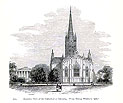
Fergusson and Pugin were in accordance when admitting that the Gothic architecture was an excellent style based on the 'true principles'. However, they both reached the exact opposite conclusions from each other from the same premise. While Pugin used to apply the Gothic style to new buildings, Fergusson criticized resolutely the imitations of past styles. Although I have to omit here the detail of his theory, he wrote in the introduction to his "Handbook" roughly as follows; (*19)
'Our knowledge of the style becomes greater, the heavier will our chains become, and anything like originality or progress in this important branch of architecture more absolutely impossible'. On the other hand, 'in civil engineering, the lowest and most prosaic branch of architectural art, our progress has been brilliant and rapid'.
Fergusson was radical. This insistence that reminds us of Le Corbusier's critical book "Quand les Cathédrales étaient Blanches (When the Cathedrals were White)" might be regarded as the logic of a 20th century avant-garde architect rather than that of a 1855 historian. (*20)
However, Fergusson was not satisfied here either. 'Art, however, will not be regenerated by buildings so ephemeral as Crystal Palaces, or so prosaic as Manchester warehouses, nor by anything so essentially utilitarian as the works of our engineers'. 'Having commenced at the bottom, the true system may extend upwards, and come at last to be applied to our palaces and churches'. After our long wanderings in the dark by 'a false system, daylight may again enlighten our path and gladden our hearts'.
As the scope of architecture that the "Handbook" had covered had been exclusively the ancient and middle ages, Fergusson wrote a history of post-Renaissance architecture as a sequel. This is the "History of the Modern Styles of Architecture" published in 1862, which, he wrote in the preface, might be considered either 'as the third volume of the "Handbook" or treated as an entirely separate work complete in itself'. (Hereafter it is abbreviated to the "Modern Styles" in this article.)
The book's descriptions of architectural history by region alongside, in the previous volumes, visual woodcut figures are quite useful as printed records and materials.
What Fergusson wrote in the "Modern Styles" is the 'history of false and mistaken architecture'. Between any of the architectural styles in the world is there no superiority or inferiority as far as being based on the 'true principles'. However, the history of architecture since the Renaissance in which architects have learned past history and styles and fell into the decay of repeating them incessantly is the 'history of false and mistaken systems'.
After Neoclassicism, colonial buildings were built in the Gothic style in India too. However, it did not suit the climate of India at all. If one constructs a Gothic church, 'various changes in arrangement must be made' such as 'the aisles of a church must be placed outside, the tracery must be double and fitted with Venetians blinds' etc. Nevertheless, revivalists did not permit it.

Then, why had European architecture since the Renaissance lost 'common-sense' and fallen into a state of constructing 'false buildings'?
Since the Age of Great Voyages, and the exploration of Asia and America, Europeans described the societies and religions they found, and their published articles and travelogues came to be referred to as 'ethnography'. Accumulation of those ethnographies on the various lands in the world would grow in due course into the sciences of 'ethnology' or 'anthropology'. When Fergusson started to classify the styles of Indian temple architecture, he divided it into 'Northern Hindu Style' and 'Southern Hindu Style' based on the phenomenon that the forms of Hindu temples in Northern India and Southern were clearly different from each other, and applied them to the racial distinction between 'Arian (i.e. Aryan) race' in the North and 'Tamul (i.e. Tamil) race' in the South, which also showed clear differences. He therefore referred to the former as 'Arian Hindu Style' too. (*24)
This might be when he began to refer to ethnographies of every region when extending his territory of writing from Indian to global architecture. If a description about architecture is only an enumeration of styles, it cannot be considered a science. Historians must systematize them while showing the distinctive features of each style. He thought that this could be called 'architectural ethnography'.
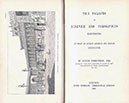
The young Friedrich Max Muller (1823-1900), who had published the most sacred epic in India the "Rig Veda" in Sanskrit, developed comparative linguistics and cultivated comparative religious studies in the middle of the 19th century, and insisted that there were close corresponding relations among languages, religions and nations. Based mainly on his theory, Fergusson adopted the classification of races in what was considered the scientific standard at that time and wrote a whole thirty-six-page chapter of 'Ethnology from an Architectural Point of View' as an appendix at the end of his "Modern Styles". (*26) This is the substance: the original seat of the Asian and European races was in Central Asia, from which races migrated four times with intervals. Those four great races are 'Turanian', 'Semitic', 'Celtic', and 'Aryan' and Fergusson insisted that each race's purity and mixture rate determined the character of its architecture. He inferred those four great race's features and described them assertively in terms of religion, government, morals, literature, arts, and sciences respectively.
Turanians, the most elusive, were the main race of the Stone Age and distributed widely from Asia to Africa. Egyptians, Chinese, Japanese, Mexicans, Tamils, Turks, Magyars, and others belong to this race. The next race, Semites, immigrated to the Middle East, consisting of Akkadians, Arameans, Hebrews, Arabians, and Ethiopians.
The race that displayed the richest artistic talents in great constructions was the Turanians, of which ancient Egyptians and Tamils or Mughals in India are typical examples. In contrast to them, Semites gave birth to the idea of absolute Gods and religions of the Creators, but were not as great in the field of architecture. The Celts conversely did not produce any great religions, mixing with other peoples everywhere they settled, but nurtured subtle and valuable arts in Europe.
It is surprising that Fergusson, who should be considered to belong to the Aryan race, reached such a race theory by studying architecture. Is this Aryan self-criticism?
His preterhuman work was achieved by the prompting of some mysterious 'power of architecture' in order to return the degenerated modern architecture again to its great height, and he devoted his life to writing architectural history and theoretical treatises on architecture.
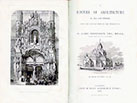
As new materials and reports on world architecture came together successively during the ten years after the publication of the "Handbook", Fergusson felt the need to make a new edition to incorporate them. On that occasion, since the "Handbook" had been written in geographical order, it was appropriate to arrange it in historical order and largely rewrite it in order to make it literally a 'history of world architecture'. The result was the two volumes of "A History of Architecture in All Countries, from the Earliest Times to the Present Day", which he was proud of as 'the first attempt to write a universal history of architecture'. (*28) The first volume was published in 1865, and the second volume, which was due to be published the next year, was delayed until 1867, when he was 59 years old. They were bulky books up to 1,500 pages along with 1,180 woodcut figures altogether, about half of which remained unchanged from the "Handbook" and the other half was a revision or enlargement of the original materials. Since his historical view itself had not altered and the method of description of the medieval architecture according to country remained essentially the same, this publication was not so sensational as the appearance of the "Handbook" ten years before. It is suitable to consider it as a book adding further detail and elaboration.
The "Modern Styles" written as the third volume of the "Handbook" was later regarded as the third volume of the "History of Architecture", so that Fergusson enhanced his fame noticeably as the historian who had completed an entire history of world architecture.
Furthermore what Fergusson passionately intended was to elaborate the history of Indian and trans-Indian architecture to evolve it into an independent volume.
The next year he published two volumes of the "History of Architecture" also as the second edition, deleting the Indian and Eastern part, revising, enlarging, and rearranging its composition. (This was intended to be the first and second volume of his 'History of Architecture'.)

A revised edition of the 'trilogy' was even published posthumously by John Murray who had provided the pubolic with most of Fergusson's writings.
The "Indian and Eastern", revised and enlarged into two volumes by J. Burgess and R. Phené Spiers, appeared in 1910, thirty-four years after the first edition. This became the definitive book on the history of Indian architecture and was read widely for a long time. How the descriptive quantity and constitution of history of Indian architecture made progress from the early "Handbook" to the entirely systematized "Indian and Eastern" is shown in the schema of 'Making a History of Indian Architecture by James Fergusson' that I have drawn up here.
As we cannot afford to thoroughly discuss this development in this article, we will particularly examine how he made his classification of architectural styles in India. What we have to make clear from the start is that since the Indus civilization was not yet known in the 19th century, the 20th century's aporia over who had been the bearers of this ancient culture had not yet existed.
In his early "Handbook", Fergusson made a distinction between Tamuls in southern India and Arians in northern India. (*29) In the paragraph of 'Ethnology of India' in the "History of Architecture", he used the word 'Dravidians' for the first time, writing that while there were indigenous people in India akin to current mountain tribes, Dravidians speaking Tamul language came first, and then Aryans speaking Sanskrit came later. (*30)
Thriving religions in India were Buddhism in ancient times, Hinduism and Jainism from early middle to modern ages, and Islam from late middle to early modern ages. Supposing that they evolved around different styles respectively, he had described Indian architecture by giving each religion's architecture a different chapter from the "Handbook" on. It was his theme to combine this method to his race theory.
Classification of architectural styles in the middle ages was most complicated. At the stage of the "History of Architecture", contrary to the "Handbook", he quit nominating 'Aryan' for 'Northern Hindu Style', applying 'Dravidian Style' to 'Southern Hindu Style'.
Although it was in the introduction of the "Indian and Eastern" that Fergusson's race theory which applied to India was minutely discussed, before the examination of it, I will explain concisely, according to its text, the classification and grouping of Indian styles he finally adopted.

Fergusson's theory about the relation between race and architectural styles having started from India, returned to India after having been hypertrophied to human history. (*31) Leaving out mythical parts based on the "Veda" or "Mahabharata", I shall look at a more concrete characterization for each race at the outset.

On the other hand, he continued, Aryan people immigrated into India around the Kali Yuga age, 3101 B.C.E., based on the Hindu theory of world cycles (*32) , and their racial purity gradually grew less definite, mixing with indigenous peoples.
Then, what sort of Turan race had settled themselves in India? Though its nomenclature had not been established among ethnologists at that time, he had already mentioned 'Dasyu' people for that race in his book "Tree and Serpent Worship", in which he had studied stupas and sculptures at Sanchi and Amaravati in 1868, and assumed that they might have been the people depicted on reliefs found at Sanchi and other ancient sites. (*33) Since Dasyus belonged to the Turan race, they were an architectural nation. The form of Hindu temples that they built in northern India is like this soaring tower with a curvilinear outline on a square base as seen below. The non-artistic Aryans did not contribute towards creating this, so the proper nomenclature for this, he wrote, would be 'Dasyu style' rather than 'Indo-Aryan Style' even if it was an unfamiliar name. (*34)
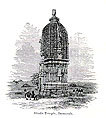
When it comes to Fergusson's history of Indian architecture, since everybody would be familiar with the 2nd edition of the "Indian and Eastern" revised by James Burgess, they could be confused by this name 'Dasyu style'.
By the way, Fergusson referred to architectural styles of medieval India with racial names such as 'Indo-Aryan Style' (or 'Dasyu Style') and 'Dravidian Style', but he could not find an appropriate ethnicity that could be applied to the style developed in the central part of India between them. He consequently designated it with a name of a dynasty that had thrived there in the Middle Ages, as the 'Chalukyan Style.'
However, Fergusson's "Indian and Eastern," which wholly systematized the architecture of India for the first time and was reinforced much by Burgess, became a monumental work in the history of studying Indian architecture, combining races, religions, and geography. It was an art historian from England, Ernest Binfield Havell (1861 -1934), who most thoroughly criticized Fergusson's classification and nomenclature of styles. He was the same generation as the Japanese philosopher, Kakuzo (Tenshin) Okakura, and took a position close to Okakura's art movement in Japan, intending to reinstate traditional arts in India while principal of Calcutta Government School of Art. That is to say a theory of unbroken continuity in Indian art, and he upbraided Fergusson, insisting it was completely absurd to emphasize differences between architectural styles based on the religions or races.
However, Havell published later in 1918 a history of India centering on art history, "The History of Aryan Rule in India", explaining that it was always Aryans and their principles that had been ruling India from ancient times up to the contemporary age. He elaborated the cultural history of India from the settlement of Indo-Aryans in India to Akbar's rule in the Mughal era from the Aryan view of history, through which he confirmed the rule of India by the English as Aryans.
Fergusson was not an ethnologist. He only applied the newest ethnology and race theory at that epoch in order to give a bone structure to his study of architectural history. The style names that he gave in such a manner are seldom made formal use of in current history of Indian architecture. (Written on July, 2001) ___ |
